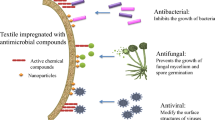Abstract
In this study, three hydrophilic monomers; 2-acrylamido-2-methyl-1-propanesulfonic acid, 2-hydroxyethyl methacrylate, diallyldimethylammonium chloride (DADMAC) were selected and their performance as an antistatic finish on nylon 6,6 fabrics was investigated. A non-thermal, high density atmospheric pressure plasma was used to graft polymerize the monomers on nylon 6,6 fabrics. Fabrics were first treated with solutions of monomer in water, air dried and then treated with helium plasma to graft polymerize the monomer on the fiber surface. Surface resistivity values were measured before and after soxhlet extraction with water. Results showed that the DADMAC monomer provided better antistatic properties to fabrics. Further studies with DADMAC monomer were made; effects of plasma post exposure time, plasma pre-exposure time, plasma power, concentration of the monomer and existence of a crosslinker were investigated. Higher plasma power, higher concentration of the monomer and longer post exposure times all gave better antistatic properties to the nylon 6,6 fabrics. Acid dye staining, UV–Vis and FT-IR measurements were conducted and results confirmed a grafted poly-DADMAC layer on the fabric surface.










Similar content being viewed by others
References
Shishoo R (2007) Plasma technologies for textiles. Woodhead Publishing Limited, Cambridge
Yasuda H (1985) Plasma polymerization. Academic Press, Orlando
Schindler WD, Hauser PJ (2004) Chemical finishing of textiles. Woodhead Publishing Ltd, Cambridge
Pionteck J, Wypych G (2007) Handbook of antistatics. ChemTec Publishing, Ontario
Gulec HA (2004) Wettability and surface energy measurements of plasma polymerization modified surfaces. PhD thesis, Hacettepe University (Ankara, Turkey)
Zubaidi B, Hirotsu T (1996) Graft polymerization of hydrophilic monomers onto textile fibers treated by glow discharge plasma. J Appl Polym Sci 61:1579–1584
Hirotsu T, Asai N (1991) Graft polymerization of 2-hydroxyethyl methacrylate onto plasma pretreated cotton, silk, and polyester fibers. J Macromol Sci A 28(5):461–473
Sarma S (2009) Ionic-modified antistatic finishes: a combination of nanotechnology and atmospheric plasma treatment. MS thesis, North Carolina State University, Raleigh, USA
Uchida E, Uyama Y, Ikada Y (1991) Antistatic properties of surface-modified polyester fabrics. Text Res J 61:483–488
Malshe P, Mazloumpour M, El-Shafei A, Hauser P (2012) Functional military textile: plasma-induced graft polymerization of DADMAC for antimicrobial treatment on nylon-cotton blend fabric. Plasma Chem Plasma Process 32:833–843
Thome J, Hollander A, Jaeger W, Trick I, Oehr C (2003) Ultrathin antibacterial polyammonium coatings on polymer surfaces. Surf Coat Technol 174:584–587
ApJet (2011) www.apjet.com. Accessed 21 May 2011
Technical Manual of the American Association of Textile Chemists and Colorists (2011) 86:97–98
Spectroscopy Tutorial: Reference (2015) http://orgchem.colorado.edu/Spectroscopy/specttutor/irchart.html. Accessed 10 Nov 2015
Table of IR Absorptions (2015) http://www.chem.ucla.edu/~webspectra/irtable.html. Accessed 10 Nov 2015
Widodo M (2011) Plasma surface modification of polyaramid fibers for protective clothing. PhD thesis, North Carolina State University, Raleigh, USA
Acknowledgments
The author would like to acknowledge The Scientific and Technological Research Council of Turkey (TUBITAK) and North Carolina State University (NCSU) for the financial support of the project. The authors would like to acknowledge Dr. Abdel Fettah Seyam and his team for their support and assistance with antistatic testing.
Author information
Authors and Affiliations
Corresponding author
Rights and permissions
About this article
Cite this article
Gul Dincmen, M., Hauser, P.J. & Gursoy, N.C. Plasma Induced Graft Polymerization of Three Hydrophilic Monomers on Nylon 6,6 Fabrics for Enhancing Antistatic Property. Plasma Chem Plasma Process 36, 1377–1391 (2016). https://doi.org/10.1007/s11090-016-9722-5
Received:
Accepted:
Published:
Issue Date:
DOI: https://doi.org/10.1007/s11090-016-9722-5




